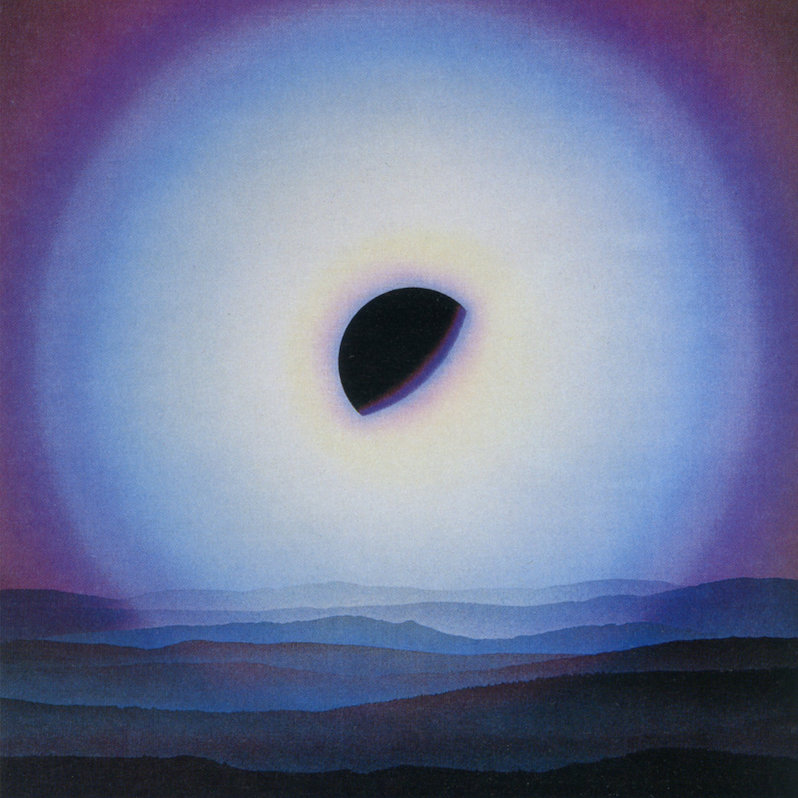Various Artists: Somewhere Between: Mutant Pop, Electronic Minimalism & Shadow Sounds of Japan 1980-1988

When I first saw Koichi Sato’s cover art for the new Light in the Attic Records compilation Somewhere Between: Mutant Pop, Electronic Minimalism & Shadow Sounds of Japan 1980-1988, I was reminded of the painter Agnes Pelton’s 20th-century spiritual abstractions. Andrea K. Scott, writing for The New Yorker, characterized Pelton’s work as “color-drenched mysticism,” and if there’s something mystical about this new LITA comp, it may be related to a mystical liminality central to the approach of the record’s curators: Yosuke Kitazawa and Mark “Frosty” McNeill. Exploring the spaces in between genres, materiality and immateriality, accessibility and experimentalism, the aptly named Somewhere Between stands out even among Light in the Attic’s recent compilations of music from 80s and 90s Japan: Kankyō Ongaku and Pacific Breeze parts one and two.
Kankyō Ongaku and Pacific Breeze both attempted to compile a variety of sounds under the umbrella of genre—in Kankyō Ongaku’s case, ambient, in Pacific Breeze’s case, city pop. The collection of sounds was often varied; a genre that includes Haruomi Hosono’s deeply awkward, quirky love song “Sports Men” and Minako Yoshida’s smooth-as-hell “Midnight Driver” is wide-ranging indeed. This time around, in attempting to paint a more inclusive portrait of the breadth of musical experimentation in Japan in the ’80s, Light in the Attic embraces more indeterminate sounds, taking a thematic rather than a genre-based approach in representing the music of the period.
Somewhere Between’s focus, to the extent that it has one, is its inability to be easily defined. As the label put it in a press release, this collection is “bound more by energetic vibration than by shared history, genre or scene… a celebration of freedom found in floating.” As such, it includes a variety of disparate genres—described variously as ambient pop, minimalism, underground electronica, and “shadow sounds,” all of which, according to Light in the Attic, share a haziness that resists clear designations and compartments, aesthetic or otherwise. The record, as a result, sits comfortably in its in-between space, not only in terms of the sounds in general, but in terms of its relationship to the previous documentation of the period. On this record, you’ll notice ambient moments reminiscent of Kankyō Ongaku, but there are likewise plenty of pop moments as well (as on the infectious synth pop of Dip in the Pool’s “Hasu No Enishi”), which fans of Pacific Breeze will appreciate. And yet, at every turn, this record is wonkier, woozier, and less predictable than those which preceded it.
These songs, though often driven by danceable beats that at times may call to mind various tracks off the Pacific Breeze comps, are at all points spookier and more mischievous than what one would traditionally categorize as pop music. This is evident at the outset, from the opening one-two of Noriko Miyamoto’s “Arrows & Eyes” and Mishio Ogawa’s “Hikari No Ito Kin No Ito.” The latter features haunted house whirs that become part of the beat rather than serving as mere ambient backdrop.
Alongside these moments of weirdo pop sit truly abstract and experimental exercises, such as the music-box-turned-malfunctioning robot that is “WEIMAR 22,” by R.N.A-ORGANISM. But the compilation is so well-sequenced that the songs which lean toward the experimental—which still have pop sensibilities—balance and alternate with the “pop” songs, which themselves embrace eccentricity and experimentation. Take, for example, Wha Ha Ha’s “Akatere,” one of the stranger songs on the record, which shifts between a collage of growling bass, wailing sax, and disturbed water and bubbly pop runs at the drop of a hat. Not only does the song itself encompass the range of tones on this compilation, but it immediately follows one of the compilation’s most accessible moments in the aforementioned “Hasu No Enishi.” The sequencing is a key component of the compilation’s larger project of complicating aesthetic boundaries; they show how the supposed divide between pop and experimental music is tenuous and often reductive in the first place.
Light in the Attic’s new compilation, even more so than its essential predecessors, crucially acknowledges the difficulty of compilations themselves. Somewhere Between addresses the danger of representing a cultural-artistic moment in monolithic terms, as well as the fact that doing so often risks leaving out truly important works of art that don’t fit so neatly into the narrative. In seeking to remedy this problem, Light in the Attic Records has made something truly rewarding in its variety and singularity.
Label: Light in the Attic
Year: 2021
Similar Albums:




